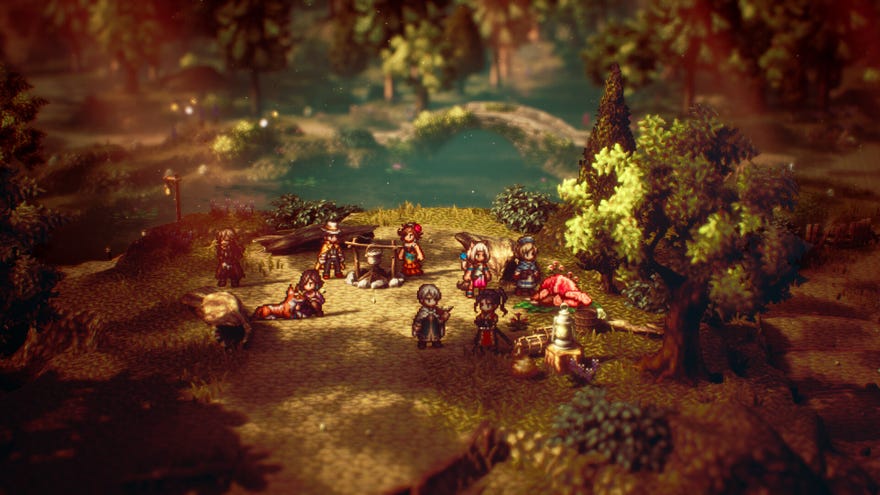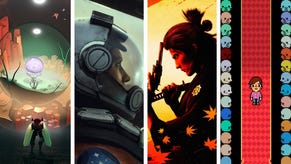Octopath Traveler 2 review: the flawed JRPG returns for more of the same
The path well travelled
You know that famous saying about those who forget the past are forever doomed to make the same mistakes? That's Octopath Traveler 2 in a nutshell, a JRPG that follows so precisely in the footsteps of its predecessor that you'd be forgiven for thinking it was suddenly 2019 again and that the last few pandemic years were nothing but a terrible existential nightmare. But alas, here we are in 2023 with another Octopath Traveler game that is, bar a couple of very light tweaks and additions, exactly the same game as what came before it, for better and for worse.
Let’s start with what’s different. The big one is that Octopath Treveler 2 is set on a completely different continent with eight fresh traveller stories to pursue, meaning you can come to this without any prior knowledge of the first game and still have a great time. There's some evolutionary work at play here in how its battle system operates and the way its character stories have been given a bit more connective tissue this time round (more on that in a sec), but the basic nuts and bolts are fundamentally the same.
As before, you get to pick one of its eight heroes to serve as your main (and permanently locked) protagonist in order to kick things off, and once you've completed their opening chapter you're then free to travel in any direction you want to pick up the rest of the crew, and pursue their own four-chapter story arcs in whatever order you like. And also like the first game, Octopath Traveler 2 doesn't properly end until you've finished all eight character stories and unlocked and completed the secret 'Final' chapter that ties it all together.
In some ways, I'm glad that Square Enix and fellow co-developers Acquire haven't forgotten what makes Octopath Traveler brilliant: its turn-based battle system continues to be a compelling centrepiece in this enormous undertaking, propping up its eight individual storylines with moreish, climatic setpieces, even when the fuel powering its plotlines has long since run dry. Players of Square Enix's Bravely Default games will immediately recognise the glee and satisfaction of storing and saving up turns to unleash in an almighty burst of powered up pain, and Persona fans will continue to revel in the way you can break and daze enemies big and small by exploiting their very specific crop of individual weak points, which are meticulously uncovered by whacking them with every single weapon and spell at your current disposal.
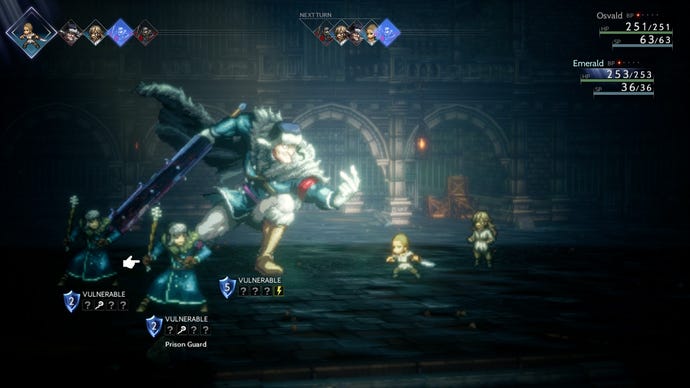
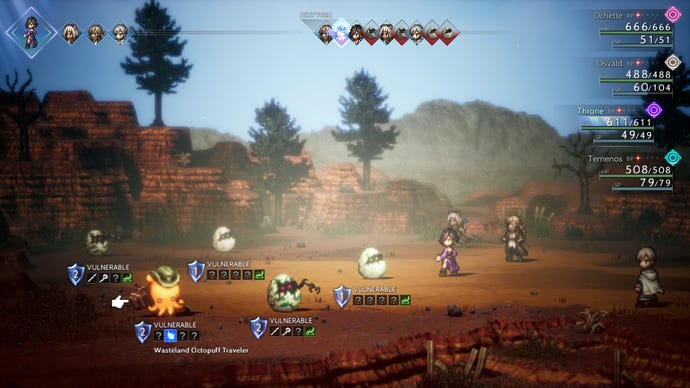


This process of identifying and narrowing in on an enemy's vulnerabilities, bringing down their defences one notch at a time before finally timing their 'break' point just right in order to 'boost' your party's attacks in the next turn when they're too stunned to move remains Octopath Traveler 2's greatest strength. The way characters pulse with energy as they boost up to their maximum turn count, gusts of wind and glowing light billowing out from under their tiny pixelated feet, delivers an exquisite power curve that even the best Final Fantasy games can struggle to match these days, and it manages to do it all without the aid of screen-hogging summon monsters, too. Plus, when each battle is accompanied by the soaring battle themes from returning composer Yasunori Nishiki, you can’t help but look forward to each and every encounter.
Octopath Traveler 2 builds on its predecessor’s excellent battle system by adding new 'latent powers' for your cast of heroes. They're essentially limit breaks by another name – special abilities that trigger once each character's been hit enough times to fill up the tiny circular meters above their HP bars. They don’t fundamentally change the rhythm of your battle tactics per se, but they’re enough of a trump card to turn the tide in large boss fights, and crucially add some much-needed variety to what are essentially the exact same eight character classes you've probably played before. As in the first game, you've got your standard sword and polearm-wielding warrior, your dagger-y thief and dancer, your axe and bow-carrying hunter and apothecary, spellcasting scholar and cleric, and the slightly useless merchant, who prefers to chuck money (and other hired muscle) at their problems rather than contribute anything themselves.
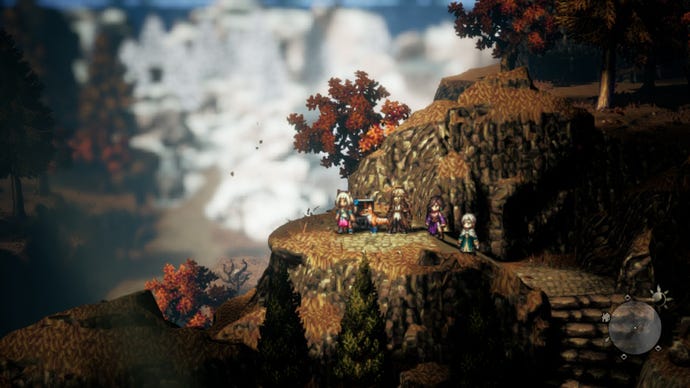
It's a shame Octopath Traveler 2 hasn’t branched out in this respect. While there are four new ‘secret’ job types to be found in the wider world map, the basic classes that you’ll be spending the majority of the game with do all largely feel identical to the first Octopath. The attacks might have different names, but they all fall into the same broad categories that returning players will instantly recognise. If you missed Octopath Traveler the first time round, congratulations! You have one of today's best JRPG battle systems to look forward to here. But as one of those returning players, I was a mite disappointed. With little incentive to shake things up, I quickly fell back into the same old tactics I used before, and even its returning secondary job system gave me little impetus to experiment with different class combos. Sure, you could probably force some more interesting synergies into existence by deliberately mismatching different class types, but why deliberately stab yourself in the foot like that when its difficulty curve is already reasonably steep?
Still, even if its character classes have remained fairly static, the construction of its eight individual stories has at least made some encouraging movements in the right direction. Small ones, mind, but at least they don’t all follow the same rinse-repeat cycle of ‘dialogue, dungeon, boss fight’ anymore. Most chapters still follow this template to some degree, of course, culminating in a dramatic, over the top boss fight, but how you get there is a lot less formulaic, whether that’s having a chapter split over multiple locations this time, or some simply opting not to have a boss fight at all. They’re baby steps, sure, but I found it was nevertheless an effective remedy to Octopath’s previous late-game slump.
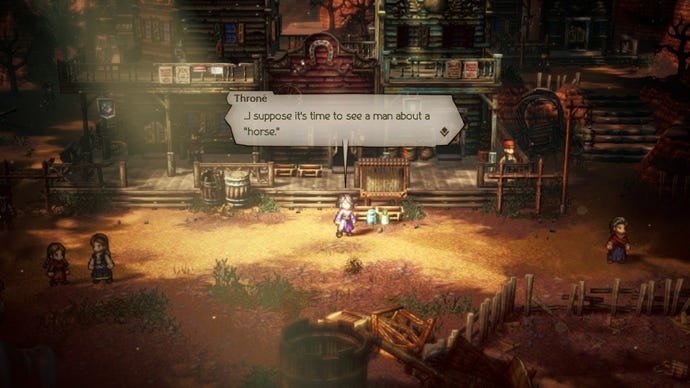
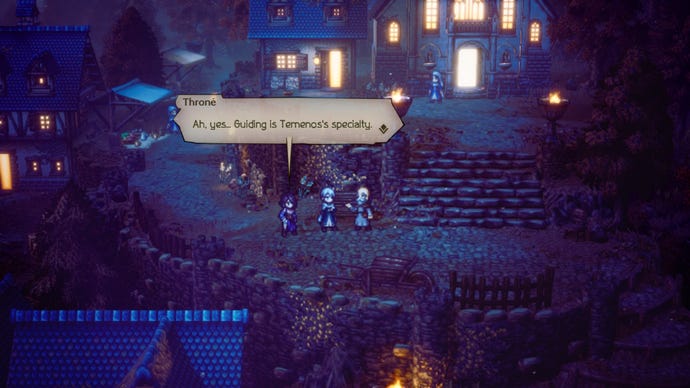
This is helped in part by the introduction of a new day and night cycle, which gives your characters different ‘path actions’ to inflict on NPCs depending on the time of day. Your apothecary might be able to inquire about people in need during the day, for example, but at night they’re able to create concoctions to put them to sleep and ease their troubles. Admittedly, many of these new options are simply riffs on pre-existing powers held by other members of your team – your thief can also incapacitate enemies, for example, while your cleric can interrogate the same information out of them by ‘breaking’ them in battle (the latter being the most sinister addition to this sequel by far, despite being functionally the same as what your thief and medic achieve). They are, in short, just more ways of achieving the same thing as before, without actually bringing anything new to the table.
During cutscenes [...], the rest of your party effectively don’t exist, only showing up to help biff the big bad before buggering off again.
But when you consider Octopath Traveler 2’s other big problem, this marginally wider set of actions does at least make them feel like more rounded individuals than their predecessors – and yep, that big problem is exactly the same one I had with the first game. For despite having eight-strong party at your disposal, their individual stories still don’t mesh very well to create a convincing whole. Sure, your active party members will faithfully trundle about behind your main protagonist, but during cutscenes and important moments of exposition, it’s only ever the central character whose plot you’re following that’s ever onscreen - the rest of your party effectively don’t exist in those moments, only showing up to help biff the big bad before buggering off again.
It's understandable, given the freeform structure of the whole thing, as you simply can’t guarantee other characters will even be there or in your current party at any given moment. Admittedly, more effort has been made to rectify this here, with standalone ‘Crossed Paths’ stories unlocking at certain points to show, heaven forbid, two characters going on an adventure together. Sadly, these are little more than glorified skits (or Travel Banter moments, in Octopath’s parlance) most of the time, adding little to the wider story or their own individual plotlines. Once they’re over, it’s back to pretending everyone else doesn’t exist anymore.
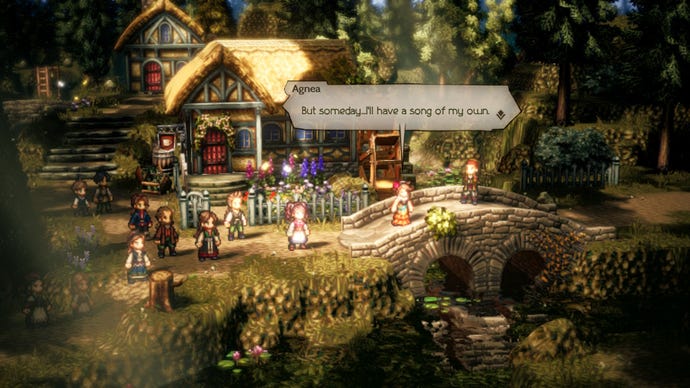
Your mileage on some of those main story arcs will vary as well. Ochette, the beastling hunter I chose as my starter hero, is a great place to start: her storyline is classic ‘the end of the world is nigh’ fare that sees her travelling the world to call home three legendary guardian creatures to protect her island home against a once-in-400-years event called The Night Of The Scarlet Moon. Given the seeming urgency of this task, however, I just can’t imagine her palling around with dancer Agnea, who at one point spends an entire in-game week entertaining the locals in a rundown city pub as she works to follow in her mother’s footsteps and become the world’s greatest dancer.
Neither can I see Hikari, an exiled prince looking to reclaim his homeland, sitting around twiddling his thumbs when there’s a usurper to take down, or indeed Osvald, a framed scholar who’s hellbent on getting revenge on the man who killed his family and chucked him in prison for several years. Castii, the apothecary, has quite a sympathetic storyline about searching to reclaim her lost memories, but merchant Partitio (much like merchant Tressa before him) once again has the weakest storyline of the bunch, which sees him trying to square doing right by his fellow workers in a world run by capitalists. Cleric Temenos is quite good fun, a smirking Sherlockian inquisitor type who’s trying to solve a mysterious death plot against his church, but both he and thief Throné’s story arcs (the latter’s quest being to break free of her mercenary assassin shackles) ultimately feel like reheated leftovers from the first Octopath game, which saw other character types dealing with very similar death cults and horrible foster parent boss figures in almost exactly the same fashion.

Octopath Traveler 2 still hasn’t solved the problem of what happens to the four characters waiting in the wings while you’re off doing another storyline, either. You can swap them in whenever you get to a tavern, but the rest of the time they just sit there, not accumulating EXP or being at all useful. As such, I started to see exactly the same level gaps emerge as the game went on, where my strongest and best fighters were often ten levels ahead of my weaker backup squad. It is a fraction easier to grind them up this time round, the new night cycle offering stronger monsters than those around in the daytime, but grinding in itself still feels like a somewhat tiresome solution to an issue that many other JRPGs – many of them made by Square Enix themselves - managed to fix ages ago.
The daft thing is, I don’t think this would be so much of a problem if Octopath Traveler 2 had a more straightforward story – one that ended properly when you completed all eight character arcs. But with the threat of that final chapter looming over you – which, in the previous Octopath game involved a mad boss gauntlet and final big bad fight that required all eight characters to be levelled up significantly higher than what I managed in the natural course of playing the game (I got four to Lv.65-ish, but the rest were stuck at Lv.50-odd) – it’s a shame this sequel still kinda hates you in all the same ways it did before. Admission time: I haven't yet got to said final chapter, but it does exist (and due to embargo restrictions I wouldn't be able to tell you about it even if I had). But given everything I’ve just talked about in this review, I can’t help but feel a terrible sense of dread towards it. If this 80-odd hour adventure ends with me throwing up my hands again and saying, ‘Mate, I’m out, you can have this world and everyone in it,’ I’ll… well, you know what I said about failing to learn from past mistakes. At this rate, I’ve probably only got myself to blame.
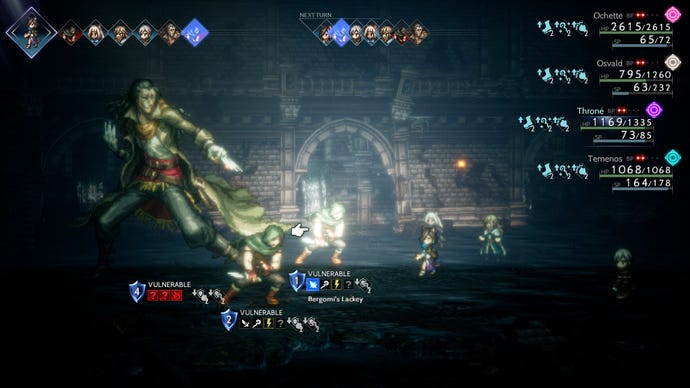
And yet.
Despite knowing this moment is almost certainly in my future, and despite the slightly incredulous realisation that I’ll have spent another 80 hours playing almost exactly the same game I did four years ago, I've still had a good time with Octopath Traveler 2. There’s something innately enthralling about it, and while, deep down, there's still lots of things I dislike about it, cor, those battles are just the absolute business. It remains one of the most captivating combat systems in the entire JRPG genre, and it really does feel good to be back in its gorgeous HD-2D world again, reheated story leftovers and all (and I swear I’m not just saying that because we get another stonking Nishiki score to admire in the process, honest). It probably doesn’t need to exist, given how little it moves the dial forward, but I’m glad it does nevertheless – and hey, if you missed the boat the first time round, you may as well just start right here. One day, I’ll finally make good on my promise to give up this ludicrous, stubborn behemoth of a series, but for now at least, this is one mistake I’ll happily go another round on, grievances be damned.
